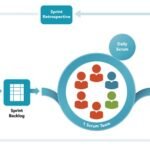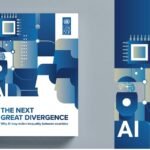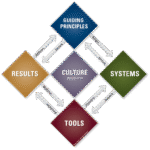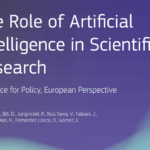
In today’s competitive world, the industry faces unprecedented pressure. The demand for customized products, shorter life cycles, global supply chains, and the imperative need to be more efficient and sustainable are just a few of the challenges. Surviving is no longer enough; to thrive, companies must evolve. The answer to this challenge is not to work harder, but to work smarter. This is where Industrial Artificial Intelligence (IAI) emerges not as a futuristic option, but as a present strategic necessity.
In this new context, Artificial Intelligence applications significantly enhance capabilities in the industrial sector (Javaid et al., 2022), driving the creation of smart factories where everything is carried out intelligently and automatically at each cycle of the manufacturing process (Kim et al., 2022).
This article is your guide. We will explore everything from fundamental concepts to a practical roadmap for implementation, demystifying the technology and showing you how IAI can become the engine of growth and efficiency for your organization.
What is Industrial Artificial Intelligence (IAI)?
Industrial Artificial Intelligence, or Artificial Intelligence in Industry, often abbreviated as IAI, refers specifically to AI applied to the manufacturing industry (Kim et al., 2022); in this sense, IAI is the specific application of artificial intelligence techniques, such as Machine Learning (ML) and Deep Learning, to data generated in industrial environments. The goal of Industrial Artificial Intelligence is not to create human-like consciousness, but to solve complex, real-world problems in manufacturing, energy, logistics, maintenance, and other heavy industries.
Think of it this way: if general AI is a physician with broad knowledge of all medicine, IAI is a specialist surgeon with deep and expert knowledge in a specific area. Industrial Artificial Intelligence uses massive data from sensors, machines (IoT), control systems, and management systems (like a CMMS or ERP) to learn patterns, predict outcomes, and automate complex decisions, optimizing processes at a scale and speed unattainable for a human.
Classification of Industrial Artificial Intelligence
The study by Leng et al. (2024) presents a classification of Industrial Artificial Intelligence (IndAI) based on levels of intelligence, which include: Shareable IndAI, Autonomous IndAI, Learnable IndAI, Knowledgeable IndAI, and Reactive IndAI.
The key distinction: Industrial AI vs. General AI
It is crucial to understand that not all AI is the same. The AI that recommends series on Netflix or the voice assistant on your phone (General or Consumer AI) operates with very different objectives and data than Industrial Artificial Intelligence.
Table 01. Industrial Artificial Intelligence vs. General Artificial Intelligence.
| Característica | Inteligencia Artificial General (de Consumo) | Inteligencia Artificial Industrial (IAI) |
| Objetivo principal | Mejorar la experiencia del usuario, personalización, interacción humana. | Optimizar procesos, aumentar la eficiencia, predecir fallos, mejorar la seguridad. |
| Fuentes de datos | Clics, historiales de búsqueda, “me gusta”, datos demográficos, voz, imágenes. | Datos de sensores (presión, vibración, temperatura), PLC, SCADA, imágenes de cámaras industriales, registros de mantenimiento. |
| Naturaleza de los datos | A menudo no estructurados y de gran volumen (Big Data). | Series temporales, datos de alta frecuencia, datos de ingeniería estructurados. La calidad y el contexto son críticos. |
| Tolerancia al error | Relativamente alta (una mala recomendación de película no es crítica). | Extremadamente baja (un fallo en la predicción puede causar paradas de planta millonarias o accidentes). |
| Enfoque | Interacción Humano-Computadora (HCI). | Interacción Máquina-a-Máquina (M2M) y Sistemas Ciberfísicos (CPS). |
| Resultado | Automatización de tareas de marketing, personalización de contenido. | Automatización de la producción, mantenimiento predictivo, control de calidad autónomo. |
Why is Industrial AI the engine of Industry 4.0? The benefits of driving change
The adoption of Industrial Artificial Intelligence is not a technological trend; it is a business strategy with a tangible and measurable return on investment (ROI). Bharadiya et al. (2023) stated that AI improves productivity, product quality, and worker safety through work planning, product design, predictive maintenance, and the use of “cobots” (collaborative robots). In this way, companies that integrate it are gaining a decisive competitive advantage.
Exponential reduction of operational and maintenance costs
Predictive maintenance with AI is the star example. Instead of repairing equipment when it fails (reactive) or according to a fixed schedule (preventive), Industrial Artificial Intelligence analyzes data on vibration, temperature, and other parameters in real-time to predict weeks in advance when a component is likely to fail. This allows for planning repairs during scheduled downtimes, eliminating unplanned downtime, which is one of the biggest sources of economic loss.
Unprecedented improvement in quality and precision
The human eye is good, but it gets tired and is subjective. AI-powered computer vision systems can inspect thousands of products per hour on a production line, detecting, for example, micro-cracks, color errors, or assembly defects with superhuman precision and consistency. This not only reduces the number of defective products that reach the customer but also minimizes material waste.
Flexibility and adaptability for a changing market
Industrial Artificial Intelligence allows production lines to be more flexible. It can automatically recalibrate machines to switch from one product to another (custom manufacturing) or dynamically adjust production parameters based on the quality of the raw material. In supply chain management with AI, algorithms can forecast demand spikes and optimize inventory levels and logistics routes in real-time.
Data-driven decision-making, not based on intuition
Plant managers and operations directors often rely on their experience, which is valuable but limited. Industrial Artificial Intelligence processes millions of data points to uncover hidden bottlenecks, energy inefficiencies, or unexpected correlations between process variables. It provides advanced insights that transform decision-making from an art into a science.
Sustainable innovation and competitiveness
By automating repetitive and dangerous tasks, IAI frees up skilled workers to focus on innovation, process improvement, and complex problem-solving. This not only increases job satisfaction but also fosters a culture of continuous improvement that keeps the company at the forefront.
The technologies that make Industrial AI possible
Industrial Artificial Intelligence is not a single technology, but the convergence of several powerful innovations.
Machine Learning and Deep Learning: The brain of the system
Machine Learning (ML) is the subfield of AI that allows systems to learn from data without being explicitly programmed; while Deep Learning, a more advanced branch of ML, uses deep neural networks to identify even more complex patterns, making it ideal for image analysis (computer vision) or complex sensor data.
Kim et al. (2022) highlight that deep learning is beginning to replace traditional data analysis techniques, as it allows for capturing complex patterns in training data and recognizing various types of unstructured data, which has led to tremendous success in areas such as object detection, natural language processing, speech recognition, and the synthesis of realistic images.
Internet of Things (IoT): The “Senses” of the factory
The Industrial Internet of Things (IIoT) refers to the network of sensors, machines, and connected devices that collect and transmit data. They are the “senses” of the factory, providing the constant flow of information that AI algorithms need to “understand” what is happening in the physical world.
Digital Twins: Simulation for perfection
A digital twin is a detailed virtual replica of a physical asset (like an engine or an entire production line). It is fed with real-time data from the actual asset. With a digital twin, one can simulate the effect of a change in a process, test different maintenance strategies, or predict how equipment will age, all in a risk-free virtual environment.
According to Javaid et al. (2022), a digital twin can be used to track and evaluate the manufacturing process and determine if quality issues may arise in the products.
Edge Computing: Instant intelligence at the network’s edge
Not all decisions can wait for data to travel to the cloud and back. Edge Computing involves processing data and running AI algorithms directly on or near the device where the data is generated (for example, in a smart camera or a controller on the machine itself). This is crucial for applications that require a near-instant response, such as detecting security failures or high-precision robotic control.
Practical applications of AI that are already transforming the industry
The theory is interesting, but the true value of Industrial Artificial Intelligence lies in its practical applications. AI is a fundamental driver for Industry 4.0, powering a digital transformation that spans from production planning and product design to supply chain management, quality, predictive maintenance, and safety (Javaid et al., 2022).
Predictive maintenance: From reactive to proactive
As mentioned, this is the star application. It analyzes historical and real-time data to predict failures in critical machinery and equipment (Javaid et al., 2022), optimizing maintenance strategies and maximizing uptime.
Automated quality control and Computer Vision
Javaid et al. (2022) highlight that AI completely automates the control of the different stages of production processes and allows for real-time refinement of any manufacturing stage based on product specifications.
AI-powered cameras inspect products for defects at speeds and accuracies impossible for humans, ensuring consistent quality and reducing the costs of non-quality.
Production and supply chain optimization
AI algorithms analyze the entire value stream, from the acquisition of raw materials to final delivery. They optimize production schedules, manage inventory predictively, and plan the most efficient logistics routes to reduce costs and improve delivery times.
Intelligent Robotics and Advanced Automation
Ribeiro et al. (2021) studied Robotic Process Automation (RPA) along with Artificial Intelligence (AI) for processes related to Enterprise Resource Planning (ERP) systems in the context of Industry 4.0; and found that RPA tools enhance their functionalities with AI objectives, improving the accuracy and execution of RPA processes in information and process extraction, recognition, classification, forecasting, and optimization.
In this context, AI is fundamental for automation and smart manufacturing, enabling robots to learn complex and high-dimensional dynamics, recognize objects, and learn control policies in dynamic environments (Kim et al., 2022).
AI-equipped industrial robots can perform complex and non-repetitive tasks. They can adapt to changes in their environment, collaborate safely with humans (cobots), and self-calibrate for tasks such as high-precision welding, assembly, or packaging.
Virtual assistants and chatbots for operations
A maintenance technician can use a maintenance chatbot to check a machine’s failure history, request a manual, or even receive step-by-step instructions for a repair. This speeds up problem-solving and democratizes technical knowledge.
AI in specific sectors: Automotive, food, pharmaceutical, and more
Automotive industry
Javaid et al. (2022) highlight that the automotive industry continues to adopt artificial intelligence services to modernize its activities. Industrial artificial intelligence is applied in the optimization of welding robots, quality control of paint, and assembly.
Food industry
AI and big data are fundamental to the transformation of the food industry, offering substantial benefits in efficiency, quality, and safety (Ding et al., 2023). AI systems are capable of performing various tasks in the food industry, including determining food quality, control tools, food classification, and prediction purposes (Mavani et al., 2022); it can also be used for product classification by quality, prediction of shelf life, and ensuring food safety.
According to Sharma et al. (2021), it was reported that AI techniques such as artificial neural networks (ANNs), genetic algorithms (GAs), fuzzy models (FL/modeling), agent-based systems (ABSs), and data mining are effective for accurate forecasting and improving production in the food industry.
For their part, Ding et al. (2023) predict that the food industry is heading towards a future based on technologies like smart agriculture, agricultural robotics, drones, 3D printing, and digital twins.
Pharmaceutical industry
AI techniques, such as machine learning (ML) and deep learning (DL), are changing the phases of drug discovery, including the identification of therapeutic targets, optimization of lead compounds, drug design, drug repositioning, and improvement of clinical trials (Yadav et al. 2024); they are also leveraging AI-based strategies to improve drug delivery, facilitating the creation of intelligent systems that target specific cells or organs, resulting in greater efficacy and a reduction of unwanted side effects (Bhatt et al. 2024).
Construction industry
Abioye et al. (2021) highlight that the construction industry, which faces productivity problems and numerous challenges, has the potential to solve many of these issues through the application of AI; and that with the increase in data generated throughout the building’s lifecycle and the emergence of other digital technologies, AI has the ability to leverage this data and the skills of other technologies to improve construction processes.
Energy industry
According to Kim et al. (2022), AI is applied in the prediction and monitoring of energy production, as well as in the detection and diagnosis of faults (FDD) in wind turbine components (blades, gearboxes, bearings) and photovoltaic systems (cells, modules, panels, arrays).
How to implement Industrial Artificial Intelligence in your company: A 5-step roadmap
Getting started with Industrial Artificial Intelligence can seem overwhelming. The key is a gradual and strategic approach. It is important to note that although different industrial sectors share common problems, the adopted AI solutions are often specific to a particular industrial sector (Jan et al., 2023), which means they may be difficult to transfer to other sectors.
Step 1: Define clear and measurable objectives (start with “why”)
Don’t implement AI for the sake of it. Identify a clear business problem. Do you want to reduce the downtime of your most critical machine by 20%? Or decrease quality defects on line X by 50%? A clear objective will guide the entire project.
Step 2: Foster a data culture (It’s your most valuable asset)
AI feeds on data. If your maintenance data is in disorganized spreadsheets or is of poor quality, your AI project will fail. It is essential to have a routine for collecting, centralizing, and validating data. Implementing modern Maintenance Software (CMMS) is often the first indispensable step.
Step 3: Start with a high-impact pilot project
Don’t try to transform your entire factory overnight. Choose a specific area or problem (as defined in step 1) for a pilot project. This will allow you to learn, demonstrate the value of the technology, and gain the organization’s support for larger projects.
Step 4: Choose the right technology and partners (Software and hardware)
Evaluate the different IAI platforms and solution providers. Look for partners who not only offer technology but also understand your industrial sector and can guide you through the process. Look for solutions that integrate with your existing systems, such as your CMMS.
Step 5: Train your team and manage change
Industrial Artificial Intelligence does not replace humans; it empowers them. Invest in training your engineers, technicians, and managers so they understand how to use these new tools. Clearly communicate the benefits and manage concerns to ensure successful adoption.
Adopting Industrial Artificial Intelligence is not without its challenges. Being aware of them is the first step to overcoming them.
The challenge of data quality and quantity
Although AI shows enormous potential, it still faces limitations such as a lack of interpretability and performance degradation with data scarcity (Kim et al. 2022). AI algorithms are only as good as the data they are trained on. Collecting clean, labeled, and relevant data is often the biggest hurdle.
Integration with legacy systems
Many factories operate with machinery and software from decades ago. Integrating modern IAI technologies with these systems can be complex and costly.
The skills gap and the need for new profiles
Personnel with hybrid skills are needed: knowledge of industrial engineering and data science. Finding and retaining this talent is a key challenge.
Security, privacy, and the human factor in the equation
Connecting critical machinery to networks increases the attack surface for cyber threats. Protecting data and systems is paramount. In addition, ethical issues arise regarding the use of data to monitor workers and the impact of automation on employment, which requires transparent and human-centered management.
The future is now: What’s next for Artificial Intelligence in Industry?
The future of Industrial Artificial Intelligence is even more integrated and autonomous. We will see systems capable of self-optimizing in real-time, supply chains that reconfigure themselves in the face of disruption, and increasingly fluid collaboration between humans and intelligent machines. Generative AI is also coming to the industry, helping to design optimized components or generate complex diagnostic reports from raw data.
For their part, Leng et al. (2024) identified three significant opportunities for IndAI towards Industry 5.0: collaborative intelligence, self-learning intelligence, and crowd intelligence.
Conclusion: Your next step towards the smart industry
Industrial Artificial Intelligence has ceased to be a vision of the future to become an operational reality that redefines the limits of efficiency, quality, and competitiveness. It is not about replacing human experience, but about augmenting it with the analytical and predictive capabilities of machines.
The path to implementation requires a clear strategy, a focus on data quality, and a commitment to change management. But the benefits—from a drastic reduction in costs to the creation of more resilient and innovative operations—are undeniable. The question is no longer whether your company should adopt IAI, but how quickly you can start.
Frequently Asked Questions (FAQ) about Industrial AI
What is the main purpose of artificial intelligence in the industry?
Mainly, it serves to optimize processes, automate complex tasks, and make smarter decisions based on data. Its most impactful applications are predictive maintenance to reduce downtime, quality control to eliminate defects, and supply chain optimization to improve logistics efficiency.
What is the difference between AI and Machine Learning in an industrial context?
AI is the general field of creating intelligent machines. Machine Learning (ML) is a specific technique within AI that allows systems to learn from data. In the industry, most “AI solutions” are, in fact, ML applications that analyze sensor data to predict outcomes.
Do I need a large investment to start using AI in my factory?
Not necessarily. The key is not the budget, but the data culture. You can start with focused pilot projects and use AI as a Service (AIaaS) platforms that reduce the initial investment. An accessible first step is to implement good maintenance software (CMMS) that centralizes your operational data.
Will AI replace jobs in the industrial sector?
Industrial Artificial Intelligence will transform jobs, not necessarily eliminate them on a large scale. It will automate repetitive and dangerous tasks, allowing workers to focus on higher-value roles that require critical thinking, creativity, and supervision of AI systems. Reskilling and the development of new skills will be essential.
What is a CMMS with AI and how does it help with maintenance?
A CMMS (Computerized Maintenance Management System) with AI, like those offered by Fracttal, goes beyond the simple management of work orders. It integrates Machine Learning algorithms that analyze data from the CMMS itself (failure history, spare parts usage, operating hours) to predict failures, optimize preventive maintenance plans, and offer intelligent recommendations to maintenance teams.
References
Abioye, S. O., Oyedele, L. O., Akanbi, L., Ajayi, A., Davila Delgado, J. M., Bilal, M., Akinade, O. O., & Ahmed, A. (2021). Artificial intelligence in the construction industry: A review of present status, opportunities and future challenges. Journal of Building Engineering, 44, 103299. https://doi.org/10.1016/j.jobe.2021.103299
Bharadiya, J. P., Thomas, R. K., & Ahmed, F. (2023). Rise of artificial intelligence in business and industry. Journal of Engineering Research and Reports, 25(3), 85-103.
Bhatt, P., Singh, S., Kumar, V., Nagarajan, K., Mishra, S. K., Dixit, P. K., … & Kumar, S. (2024). Artificial intelligence in pharmaceutical industry: Revolutionizing drug development and delivery. Current Artificial Intelligence, 2(1), E051223224198.
Ding, H., Tian, J., Yu, W., Wilson, D. I., Young, B. R., Cui, X., Xin, X., Wang, Z., & Li, W. (2023). The Application of Artificial Intelligence and Big Data in the Food Industry. Foods, 12(24), 4511.
Jan, Z., Ahamed, F., Mayer, W., Patel, N., Grossmann, G., Stumptner, M., & Kuusk, A. (2023). Artificial intelligence for industry 4.0: Systematic review of applications, challenges, and opportunities. Expert Systems With Applications, 216, 119456. https://doi.org/10.1016/j.eswa.2022.119456
Javaid Mohd, Abid Haleem, Ravi Pratap Singh, and Rajiv Suman. 2022. Artificial Intelligence Applications for Industry 4.0: A Literature-Based Study. Journal of Industrial Integration and Management, Vol. 07, No. 01, pp. 83-111 https://doi.org/10.1142/S2424862221300040
Kim, S.W., Kong, J.H., Lee, S.W. et al. Recent Advances of Artificial Intelligence in Manufacturing Industrial Sectors: A Review. Int. J. Precis. Eng. Manuf. 23, 111–129 (2022). https://doi.org/10.1007/s12541-021-00600-3
Leng, J., Zhu, X., Huang, Z., Li, X., Zheng, P., Zhou, X., Mourtzis, D., Wang, B., Qi, Q., Shao, H., Wan, J., Chen, X., Wang, L., & Liu, Q. (2024). Unlocking the power of industrial artificial intelligence towards Industry 5.0: Insights, pathways, and challenges. Journal of Manufacturing Systems, 73, 349-363. https://doi.org/10.1016/j.jmsy.2024.02.010
Mavani, N.R., Ali, J.M., Othman, S. et al. Application of Artificial Intelligence in Food Industry—a Guideline. Food Eng Rev 14, 134–175 (2022). https://doi.org/10.1007/s12393-021-09290-z
Ribeiro, J., Lima, R., Eckhardt, T., & Paiva, S. (2021). Robotic Process Automation and Artificial Intelligence in Industry 4.0 – A Literature review. Procedia Computer Science, 181, 51-58. https://doi.org/10.1016/j.procs.2021.01.104
Sharma, S., Gahlawat, V. K., Rahul, K., Mor, R. S., & Malik, M. (2021). Sustainable Innovations in the Food Industry through Artificial Intelligence and Big Data Analytics. Logistics, 5(4), 66. https://doi.org/10.3390/logistics5040066
Yadav, S., Singh, A., Singhal, R., & Yadav, J. P. (2024). Revolutionizing drug discovery: The impact of artificial intelligence on advancements in pharmacology and the pharmaceutical industry. Intelligent Pharmacy, 2(3), 367-380. https://doi.org/10.1016/j.ipha.2024.02.009
Editor and founder of “Innovar o Morir” (‘Innovate or Die’). Milthon holds a Master’s degree in Science and Innovation Management from the Polytechnic University of Valencia, with postgraduate diplomas in Business Innovation (UPV) and Market-Oriented Innovation Management (UPCH-Universitat Leipzig). He has practical experience in innovation management, having led the Fisheries Innovation Unit of the National Program for Innovation in Fisheries and Aquaculture (PNIPA) and worked as a consultant on open innovation diagnostics and technology watch. He firmly believes in the power of innovation and creativity as drivers of change and development.





